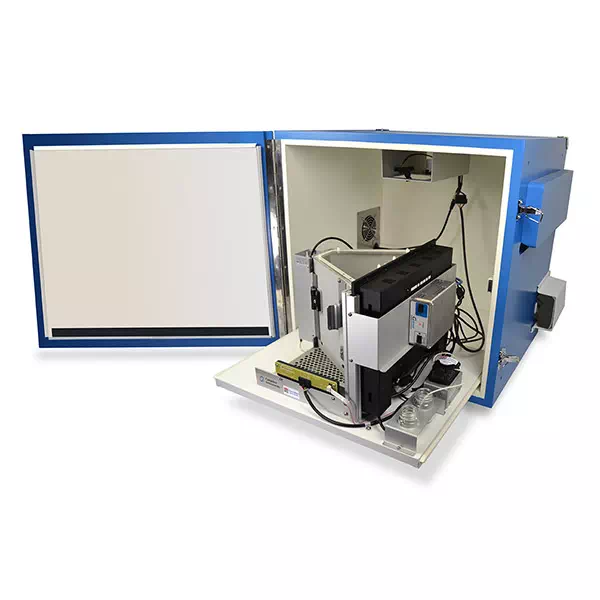Example Neural Systems Involved
- Prefrontal Cortex
- Basal Forebrain, Cholinergic (Accuracy)
- Serotonin (Impulsivity)
- Noradrenaline (Distraction)
- Dopamine (Motivation)
Clinical Areas Showing Impairment
- Alzheimer’s
- Depression
- Huntington’s
- Schizophrenia
- ADHD
- OCD
Typical Training Times
- 1-2 weeks to train to touch the screen and initiate the task
- 6-24 sessions to train to criterion for task
References:
- Desrochers, S. S., & Nautiyal, K. M. (2022). Serotonin 1B receptor effects on response inhibition are independent of inhibitory learning. Neurobiology of Learning and Memory, 187. – Abstract
- Wittkowski, J., Fritz, R. G., Meier, M., & Schmidtke, D. (2021). Conditioning learning in an attentional task relates to age and ventricular expansion in a nonhuman primate (Microcebus murinus). Behavioural Brain Research, 399, 113053. – Abstract
- Palmer, D., Dumont, J. R., Dexter, T. D., Prado, M. A. M., Finger, E., Bussey, T. J., & Saksida, L. M. (2021). Touchscreen cognitive testing: Cross-species translation and co-clinical trials in neurodegenerative and neuropsychiatric disease. In Neurobiology of Learning and Memory (Vol. 182, p. 107443). – Abstract
- Tran, B. N., Valek, L., Wilken-Schmitz, A., Fuhrmann, D. C., Namgaladze, D., Wittig, I., & Tegeder, I. (2021). Reduced exploratory behavior in neuronal nucleoredoxin knockout mice. Redox Biology, 45, 102054. – Abstract
- Rashmi Tripathi, G. mehta,Garima T. M. S. (2021). Various Test To Assess the Behaviour and Learning Skills in Rodent. Annals of the Romanian Society for Cell Biology, 25(6), 1990?2010. – Abstract
- Kaukas, L., Holmes, J., Rahimi, F., ? L. C.-P.-B. brain, & 2021, undefined. (2021). Injury during adolescence leads to sex-specific executive function deficits in adulthood in a pre-clinical model of mild traumatic brain injury. Elsevier, 402, 166?4328. – Abstract
- Lee, J., van den Buuse, M., Nithianantharajah, J., & Jones, N. C. (2020). Acute NMDA receptor antagonism impairs working memory performance but not attention in rats-Implications for the NMDAr hypofunction theory of schizophrenia. Behavioral Neuroscience, 134(4), 323?331. – Abstract
- Smith, B. L., Laaker, C. J., Lloyd, K. R., Hiltz, A. R., & Reyes, T. M. (2020). Adolescent microglia play a role in executive function in male mice exposed to perinatal high fat diet. Brain, Behavior, and Immunity, 84, 80?89. – Abstract
- Shepherd, A., May, C., Churilov, L., Adlard, P. A., Hannan, A. J., & Burrows, E. L. (2019). Evaluation of attention in APP/PS1 mice shows impulsive and compulsive behaviours. Genes, Brain and Behavior. – Abstract
- Heath, C. J., O?Callaghan, C., Mason, S. L., Phillips, B. U., Saksida, L. M., Robbins, T. W., Barker, R. A., Bussey, T. J., & Sahakian, B. J. (2019). A Touchscreen Motivation Assessment Evaluated in Huntington?s Disease Patients and R6/1 Model Mice. Frontiers in Neurology, 10. – Abstract
- Hambrecht-Wiedbusch, V. S., Latendresse, K. A., Avidan, M. S., Nelson, A. G., Phyle, M., Ajluni, R. E., & Mashour, G. A. (2019). General anesthesia does not have persistent effects on attention in rodents. Frontiers in Behavioral Neuroscience, 13. – Abstract
- Mantanona, C. P., Alsi?, J., Elson, J. L., Fisher, B. M., Dalley, J. W., Bussey, T., & Pienaar, I. S. (2019). Altered motor, anxiety-related and attentional task performance at baseline associate with multiple gene copies of the vesicular acetylcholine transporter and related protein overexpression in ChAT::Cre+ rats. Brain Structure and Function. – Abstract
- Fitzpatrick, C. M., Maric, V. S., Bate, S. T., & Andreasen, J. T. (2018). Influence of intertrial interval on basal and drug-induced impulsive action in the 5-choice serial reaction time task. Neuroscience Letters. – Abstract
- Kim, E. W., Phillips, B. U., Heath, C. J., Cho, S. Y., Kim, H., Sreedharan, J., Song, H. T., Lee, J. E., Bussey, T. J., Kim, C. H., Kim, E., & Saksida, L. M. (2017). Optimizing reproducibility of operant testing through reinforcer standardization: Identification of key nutritional constituents determining reward strength in touchscreens. Molecular Brain, 10(1). – Abstract


